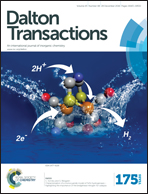The synthesis and structure of a dianionic species with a bond between pentacoordinated tin atoms: bonding properties of the tin–tin bond†
Abstract
The first dianionic compound bearing a bond between two pentacoordinated tin atoms, a distannate, was synthesized in a stable form by using two sets of an electron-withdrawing C,O-bidentate ligand on each tin atom. The structure of the distannate was determined by NMR spectroscopy and X-ray crystallographic analysis. The Sn–Sn bond of the distannate was shown to be a single bond featuring high s-character. The 1J(Sn–Sn) coupling constant was larger than that of Sn(sp3)–Sn(sp3) bonds found in most hexaorganodistannanes. This bond feature was also supported by computational studies. The Sn–Sn bond was cleaved by treatment with hydrochloric acid, which shows a different reactivity to the homonuclear bonds of pentacoordinated disilicates and digermanates.


 Please wait while we load your content...
Please wait while we load your content...